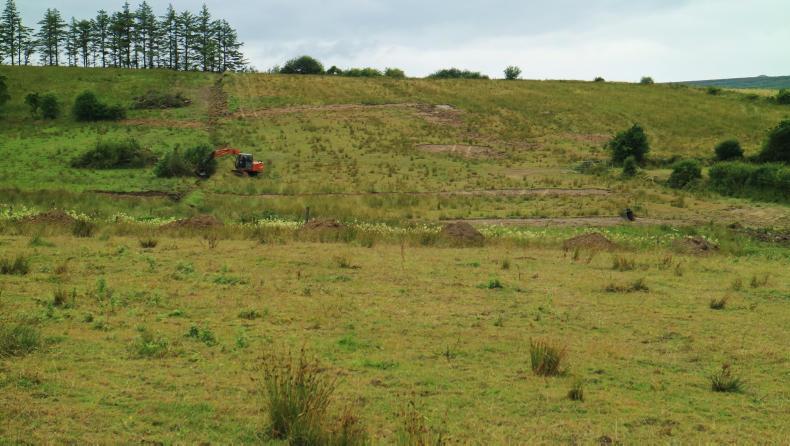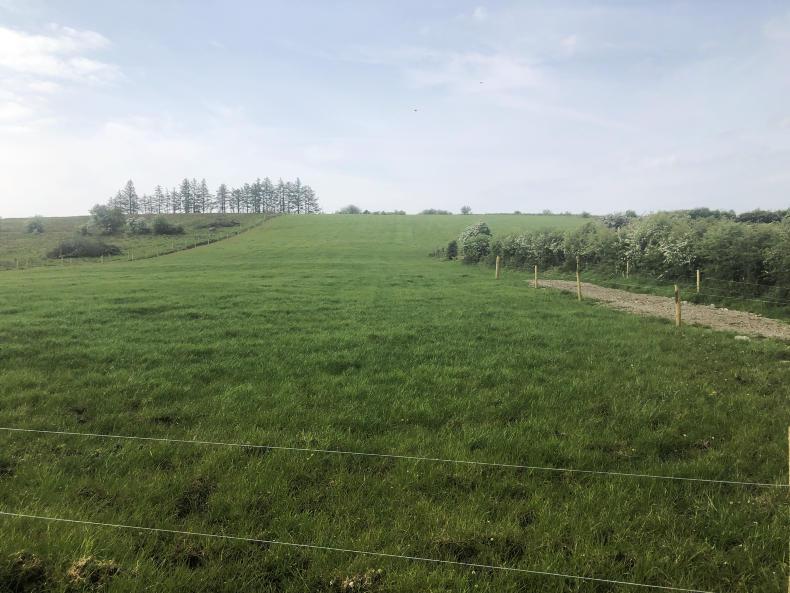Grass and breeding are two cornerstones of suckling and their contribution to overall suckler farm performance are enormous. For example, Teagasc estimates that increasing the amount of grass utilised on a drystock farm by 1t DM/ha in a year is worth as much as €105/ha. Likewise for breeding, Teagasc research into five key suckler-farm performance indicators, all driven by good breeding, showed the potential to generate an extra €300/cow net margin.
Glen McDermott, the Sligo BETTER farm beef challenge participant, is looking at both grass and breeding to unlock more potential from his farm. On 41ha (owned) plus a recently leased 16ha, he is operating a suckler to under 16-month bull and heifer beef system.
To maximise a farm’s potential, every acre of ground needs to be fully utilised. Since joining the programme, reclaiming and improving large parts of ground that were under-producing has been key. Soil fertility was the first port-of-call so lime (86t spread in 2017), slurry and compound fertilsers are all being utilised better. Some parts of the farm were dominated by rushes and this problem was corrected with MCPA and Fourfrontier sprays. However, without doubt, the most important element to improving under-performing swards was reseeding – the most significant of which took place last autumn.

Picture one: before.
Early in 2018, Glen put pen to paper on a 12-year lease for 40 acres across the road from his home block. At the time the land was in very marginal condition, the ground was rough, with rushes and old grasses dominating the majority of the sward. Since then, the transformation has been dramatic. In mid-summer work commenced on just over half of the block, with ditches and drains being cleaned. Once that was finished, the ground was sprayed off and the dead material was cut.

Picture two: after.
After that, it was reseeded. Glen did most of this himself giving it three runs of a disc harrow, which he purchased, sowing the grass seed, fertilising and rolling. A full paddock infrastructure was then installed in the back end of the year, complete with a water system and roadway serving all paddocks.
As things stand, the reclaimed ground has received an early application of urea and two applications of 18:6:12. The fourth rotation started late last week with the suckler cow AI group.
As the saying goes: an ounce of breeding is worth a tonne of feeding. For Glen, improving the breeding within his suckler herd was a major stepping-stone to improving his farm’s overall performance. “Our plan is to slaughter all bulls under 16-months and also to breed most of our replacements from within the herd at two years of age. “You need good stock to do this,” Glen explained.

A SI2469 Simmental heifer calf.
Dabbling with AI for a number years, this year 100% of breeding will be via AI. A group of 39 cows and a group of 27 maiden heifers are being run with two vasectomised bulls fitted with chin-balls. Last year, Simmental sires Lisnacrann Fifty Cent (SI2469) and Curaheen Earp (SI2152); Limousin sires Elderberry Galahad (EBY) and Castleview Gringo (GWO) and Charolais sires Fiston (FSZ), Gedeon (GEZ) and Cavelands Levi (CH4252) were used. A similar mix of maternal and terminal sires will be used this year. Each cow will receive AI a maximum of three times and each heifer will only get two chances in a bid to keep the calving period tight and fertility high.

A FSZ Charolais bull calf.
The high number of replacement heifers is required to build numbers. With 66 for breeding this year, that’s 13 more than this time last year. “I think around 80 suckler cows is my target for this farm,” he added. Of the 27 maiden heifers, roughly half are home-bred and half were purchased this spring. “I only bought four- or five-star heifers,” he said. “I do believe the stars are identifying the animals with the best breeding potential,” added Glen. Heifers between 390kg and 450kg were purchased and prices ranged from €900 to €1,100 per head.
Grass and breeding are two cornerstones of suckling and their contribution to overall suckler farm performance are enormous. For example, Teagasc estimates that increasing the amount of grass utilised on a drystock farm by 1t DM/ha in a year is worth as much as €105/ha. Likewise for breeding, Teagasc research into five key suckler-farm performance indicators, all driven by good breeding, showed the potential to generate an extra €300/cow net margin.
Glen McDermott, the Sligo BETTER farm beef challenge participant, is looking at both grass and breeding to unlock more potential from his farm. On 41ha (owned) plus a recently leased 16ha, he is operating a suckler to under 16-month bull and heifer beef system.
To maximise a farm’s potential, every acre of ground needs to be fully utilised. Since joining the programme, reclaiming and improving large parts of ground that were under-producing has been key. Soil fertility was the first port-of-call so lime (86t spread in 2017), slurry and compound fertilsers are all being utilised better. Some parts of the farm were dominated by rushes and this problem was corrected with MCPA and Fourfrontier sprays. However, without doubt, the most important element to improving under-performing swards was reseeding – the most significant of which took place last autumn.

Picture one: before.
Early in 2018, Glen put pen to paper on a 12-year lease for 40 acres across the road from his home block. At the time the land was in very marginal condition, the ground was rough, with rushes and old grasses dominating the majority of the sward. Since then, the transformation has been dramatic. In mid-summer work commenced on just over half of the block, with ditches and drains being cleaned. Once that was finished, the ground was sprayed off and the dead material was cut.

Picture two: after.
After that, it was reseeded. Glen did most of this himself giving it three runs of a disc harrow, which he purchased, sowing the grass seed, fertilising and rolling. A full paddock infrastructure was then installed in the back end of the year, complete with a water system and roadway serving all paddocks.
As things stand, the reclaimed ground has received an early application of urea and two applications of 18:6:12. The fourth rotation started late last week with the suckler cow AI group.
As the saying goes: an ounce of breeding is worth a tonne of feeding. For Glen, improving the breeding within his suckler herd was a major stepping-stone to improving his farm’s overall performance. “Our plan is to slaughter all bulls under 16-months and also to breed most of our replacements from within the herd at two years of age. “You need good stock to do this,” Glen explained.

A SI2469 Simmental heifer calf.
Dabbling with AI for a number years, this year 100% of breeding will be via AI. A group of 39 cows and a group of 27 maiden heifers are being run with two vasectomised bulls fitted with chin-balls. Last year, Simmental sires Lisnacrann Fifty Cent (SI2469) and Curaheen Earp (SI2152); Limousin sires Elderberry Galahad (EBY) and Castleview Gringo (GWO) and Charolais sires Fiston (FSZ), Gedeon (GEZ) and Cavelands Levi (CH4252) were used. A similar mix of maternal and terminal sires will be used this year. Each cow will receive AI a maximum of three times and each heifer will only get two chances in a bid to keep the calving period tight and fertility high.

A FSZ Charolais bull calf.
The high number of replacement heifers is required to build numbers. With 66 for breeding this year, that’s 13 more than this time last year. “I think around 80 suckler cows is my target for this farm,” he added. Of the 27 maiden heifers, roughly half are home-bred and half were purchased this spring. “I only bought four- or five-star heifers,” he said. “I do believe the stars are identifying the animals with the best breeding potential,” added Glen. Heifers between 390kg and 450kg were purchased and prices ranged from €900 to €1,100 per head.










 This is a subscriber-only article
This is a subscriber-only article













SHARING OPTIONS: